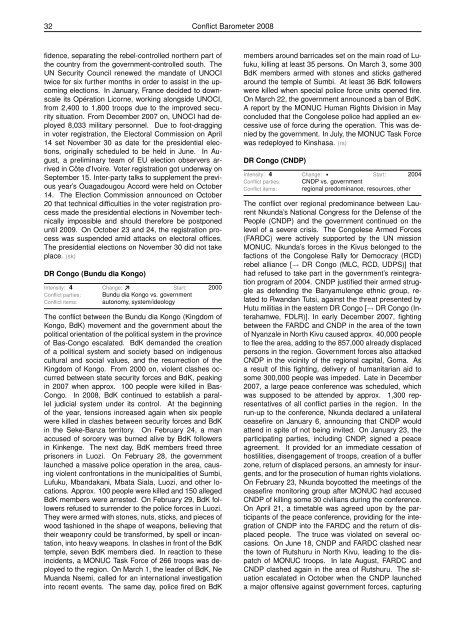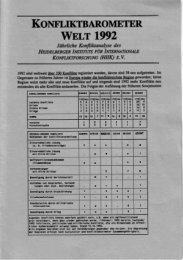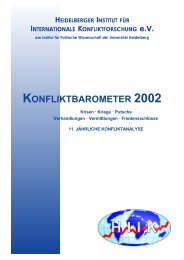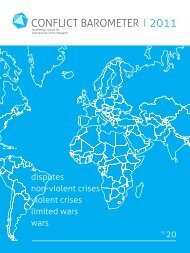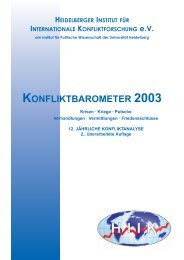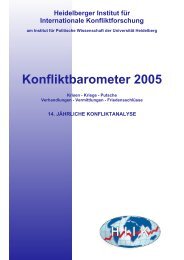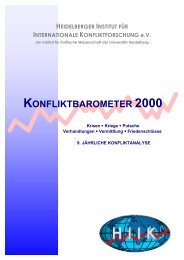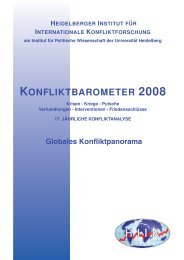CONFLICT BAROMETER 2008
CONFLICT BAROMETER 2008
CONFLICT BAROMETER 2008
You also want an ePaper? Increase the reach of your titles
YUMPU automatically turns print PDFs into web optimized ePapers that Google loves.
32 Conflict Barometer <strong>2008</strong><br />
fidence, separating the rebel-controlled northern part of<br />
the country from the government-controlled south. The<br />
UN Security Council renewed the mandate of UNOCI<br />
twice for six further months in order to assist in the upcoming<br />
elections. In January, France decided to downscale<br />
its Opération Licorne, working alongside UNOCI,<br />
from 2,400 to 1,800 troops due to the improved security<br />
situation. From December 2007 on, UNOCI had deployed<br />
8,033 military personnel. Due to foot-dragging<br />
in voter registration, the Electoral Commission on April<br />
14 set November 30 as date for the presidential elections,<br />
originally scheduled to be held in June. In August,<br />
a preliminary team of EU election observers arrived<br />
in Côte d’Ivoire. Voter registration got underway on<br />
September 15. Inter-party talks to supplement the previous<br />
year’s Ouagadougou Accord were held on October<br />
14. The Election Commission announced on October<br />
20 that technical difficulties in the voter registration process<br />
made the presidential elections in November technically<br />
impossible and should therefore be postponed<br />
until 2009. On October 23 and 24, the registration process<br />
was suspended amid attacks on electoral offices.<br />
The presidential elections on November 30 did not take<br />
place. (sk)<br />
DR Congo (Bundu dia Kongo)<br />
Intensity: 4 Change: Start: 2000<br />
Conflict parties: Bundu dia Kongo vs. government<br />
Conflict items: autonomy, system/ideology<br />
The conflict between the Bundu dia Kongo (Kingdom of<br />
Kongo, BdK) movement and the government about the<br />
political orientation of the political system in the province<br />
of Bas-Congo escalated. BdK demanded the creation<br />
of a political system and society based on indigenous<br />
cultural and social values, and the resurrection of the<br />
Kingdom of Kongo. From 2000 on, violent clashes occurred<br />
between state security forces and BdK, peaking<br />
in 2007 when approx. 100 people were killed in Bas-<br />
Congo. In <strong>2008</strong>, BdK continued to establish a parallel<br />
judicial system under its control. At the beginning<br />
of the year, tensions increased again when six people<br />
were killed in clashes between security forces and BdK<br />
in the Seke-Banza territory. On February 24, a man<br />
accused of sorcery was burned alive by BdK followers<br />
in Kinkenge. The next day, BdK members freed three<br />
prisoners in Luozi. On February 28, the government<br />
launched a massive police operation in the area, causing<br />
violent confrontations in the municipalities of Sumbi,<br />
Lufuku, Mbandakani, Mbata Siala, Luozi, and other locations.<br />
Approx. 100 people were killed and 150 alleged<br />
BdK members were arrested. On February 29, BdK followers<br />
refused to surrender to the police forces in Luozi.<br />
They were armed with stones, nuts, sticks, and pieces of<br />
wood fashioned in the shape of weapons, believing that<br />
their weaponry could be transformed, by spell or incantation,<br />
into heavy weapons. In clashes in front of the BdK<br />
temple, seven BdK members died. In reaction to these<br />
incidents, a MONUC Task Force of 266 troops was deployed<br />
to the region. On March 1, the leader of BdK, Ne<br />
Muanda Nsemi, called for an international investigation<br />
into recent events. The same day, police fired on BdK<br />
members around barricades set on the main road of Lufuku,<br />
killing at least 35 persons. On March 3, some 300<br />
BdK members armed with stones and sticks gathered<br />
around the temple of Sumbi. At least 36 BdK followers<br />
were killed when special police force units opened fire.<br />
On March 22, the government announced a ban of BdK.<br />
A report by the MONUC Human Rights Division in May<br />
concluded that the Congolese police had applied an excessive<br />
use of force during the operation. This was denied<br />
by the government. In July, the MONUC Task Force<br />
was redeployed to Kinshasa. (rs)<br />
DR Congo (CNDP)<br />
Intensity: 4 Change: Start: 2004<br />
Conflict parties: CNDP vs. government<br />
Conflict items: regional predominance, resources, other<br />
The conflict over regional predominance between Laurent<br />
Nkunda’s National Congress for the Defense of the<br />
People (CNDP) and the government continued on the<br />
level of a severe crisis. The Congolese Armed Forces<br />
(FARDC) were actively supported by the UN mission<br />
MONUC. Nkunda’s forces in the Kivus belonged to the<br />
factions of the Congolese Rally for Democracy (RCD)<br />
rebel alliance [→ DR Congo (MLC, RCD, UDPS)] that<br />
had refused to take part in the government’s reintegration<br />
program of 2004. CNDP justified their armed struggle<br />
as defending the Banyamulenge ethnic group, related<br />
to Rwandan Tutsi, against the threat presented by<br />
Hutu militias in the eastern DR Congo [→ DR Congo (Interahamwe,<br />
FDLR)]. In early December 2007, fighting<br />
between the FARDC and CNDP in the area of the town<br />
of Nyanzale in North Kivu caused approx. 40,000 people<br />
to flee the area, adding to the 857,000 already displaced<br />
persons in the region. Government forces also attacked<br />
CNDP in the vicinity of the regional capital, Goma. As<br />
a result of this fighting, delivery of humanitarian aid to<br />
some 300,000 people was impeded. Late in December<br />
2007, a large peace conference was scheduled, which<br />
was supposed to be attended by approx. 1,300 representatives<br />
of all conflict parties in the region. In the<br />
run-up to the conference, Nkunda declared a unilateral<br />
ceasefire on January 6, announcing that CNDP would<br />
attend in spite of not being invited. On January 23, the<br />
participating parties, including CNDP, signed a peace<br />
agreement. It provided for an immediate cessation of<br />
hostilities, disengagement of troops, creation of a buffer<br />
zone, return of displaced persons, an amnesty for insurgents,<br />
and for the prosecution of human rights violations.<br />
On February 23, Nkunda boycotted the meetings of the<br />
ceasefire monitoring group after MONUC had accused<br />
CNDP of killing some 30 civilians during the conference.<br />
On April 21, a timetable was agreed upon by the participants<br />
of the peace conference, providing for the integration<br />
of CNDP into the FARDC and the return of displaced<br />
people. The truce was violated on several occasions.<br />
On June 18, CNDP and FARDC clashed near<br />
the town of Rutshuru in North Kivu, leading to the dispatch<br />
of MONUC troops. In late August, FARDC and<br />
CNDP clashed again in the area of Rutshuru. The situation<br />
escalated in October when the CNDP launched<br />
a major offensive against government forces, capturing


